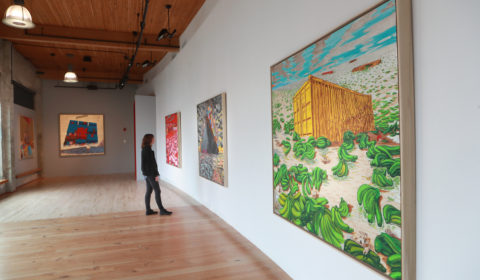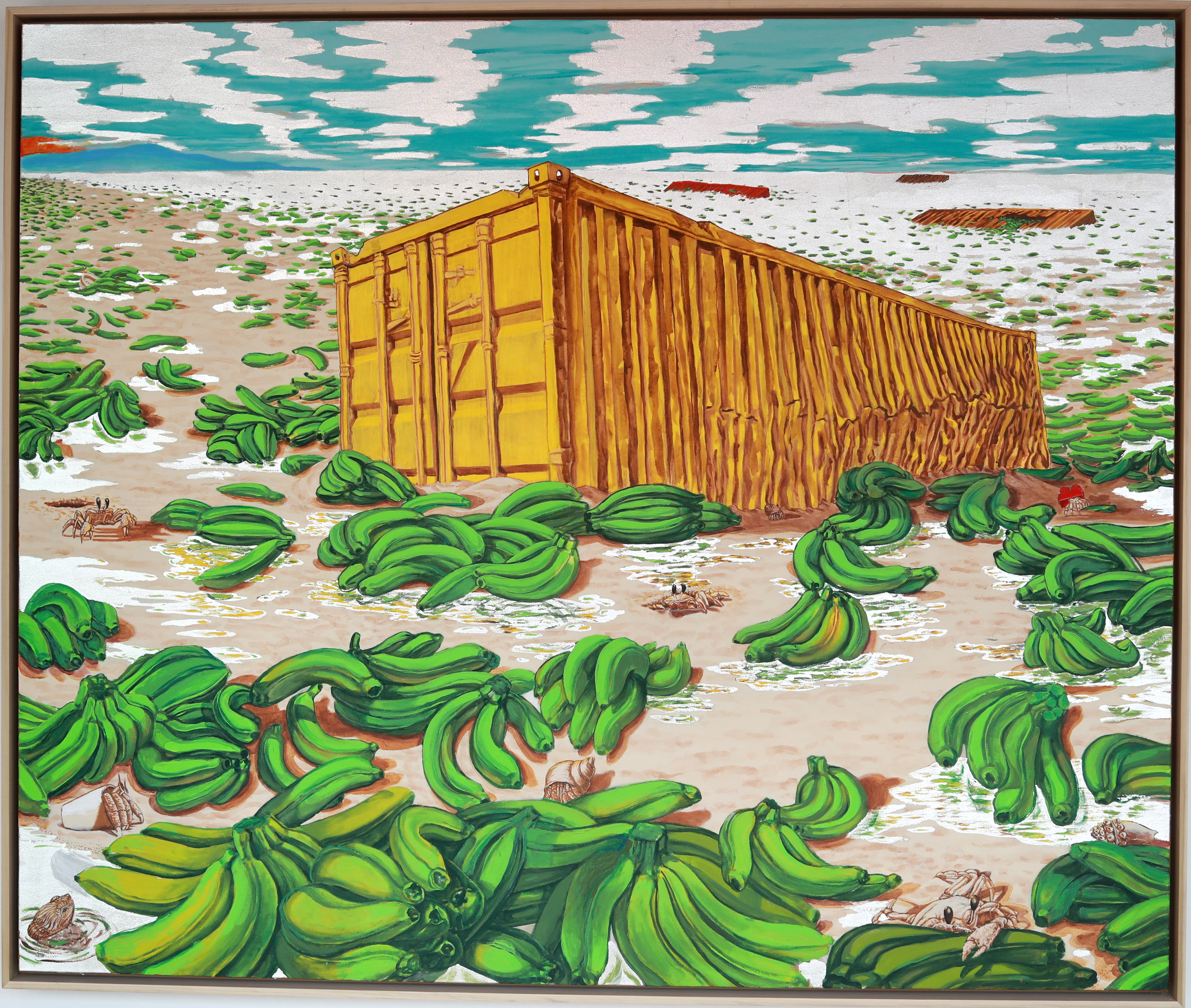“He would do these walks along the port, and see these shipping containers come in and out, and became particularly interested in the way that was shaping his relationships to the walk, to these meditative zones that are supposed to be about taking in nature and enjoying the stunning views of the Bay. It’s in the shadows, these giants cranes.” –Sampada Aranke
Scattered everywhere are green bananas. In the foreground, bunches of the unripe fruit iteratively sit upright and lie sideways on the damp, cold sand of a beach. Snails and crabs also reside on this beach. Their burnt sandy color almost camouflages the shell creatures within the sand as they move among the bananas: this fruit is their feast now. A large gold-yellow shipping crate sits centered, mid plane and suggests this feast was intended for human beings. But now shipwrecked, the looming crate sits stuck in sand, broken with an horizontal fracture at its side, with its goods—the tropical fruit from elsewhere—spilled in this location where the sand meets the sea. Something has broken this crate, this beast, this large, heavy symbol of global trade and consumerism. In the distance, three other crates meet worse fates. They, too, are even more stuck in the low-tide beach, almost submerged in the damp, dense, heavy sand water. They, too, are broken with cracks that empty out their contents: more green bananas. Hundreds of the green bunches line the sand as it turns into the sea. Some bananas have a hint of ripeness—a hint of yellow—that echoes the yellow color of the crate, and hints at the global processes, and people, that have imperfectly brought these goods from someplace else to here.
I viewed Untitled 3, 2017 (acrylic and mixed media on oil canvas) last month as part of Collapse: Recent works by Dewey Crumpler at the Hedreen Gallery in Seattle, WA. Dewey Crumpler is a Bay Area-based artist and Associate Professor of Painting at the San Francisco Art Institute. A description for the show reads:
Collapse considers the beauty and terror of financial systems and their ecological, social, and aesthetic impacts. These works take on the disturbances of potential catastrophe, rendering the container as the locus of awe, wonder, destruction, and fear. In these works, Crumpler asks us to consider how goods transported globally via ships and ports might open up other histories of destruction and creation. By citing aesthetic practices that range from religious iconography to dreamscapes of ruin, Crumpler lays bare the connective tissues between past, present, and impending futures of collapse.
The shipping crate centers all works in the show; the crate acts as a concrete signifier of port urbanism and an abstract lens to the processes and aesthetics of global capitalist processes and of blackness. To learn more about the exhibit, I spoke with its guest curator, Sampada Aranke, Assistant Professor in the Art History, Theory, Criticism Department at the School of the Art Institute, Chicago.

Dewey Crumpler, Untitled 1-5, 2017, installed at Hedreen Gallery, Seattle, WA. Photo by Yosef Chaim Kalinko, Seattle University.
JASMINE MAHMOUD: A main motif throughout the exhibition is the shipping crate. In Untitled 3, the gold yellow crate sits centered, midplane and endlessly surrounded by unripe green bananas. In Untitled 4, stacks of crates in red, green, purple, yellow, blue, grey—stacks that appear like rectangular bunches of yarn—sit piled in rows in a ship sinking a stormy sea. And in Untitled 5, perhaps an aftermath of the previous work, crates of blue, orange, and brown splash and sink (and perhaps float) into the sea. How does the motif of the crate dialogue with urban, spatial, and geographic claims that Dewey Crumpler makes in his work?
SAMPADA ARANKE: I call the show Collapse, and the series actually doesn’t have a unifying title or a kind of gathering conceptual umbrella except for the crates that keep coming up. That really comes up with Dewey … taking these walks along the bayfront in Oakland and Berkeley, and the port being this really dominant place. Dewey writ large has always been … he’s within the Black Radical Tradition, he’s has a really engaged critique of capital and of commodification, and that’s been a vibrant tenor in his work for years.
Read the full post on Urban Cultural Studies.
